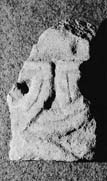Select a site alphabetically from the choices shown in the box below. Alternatively, browse sculptural examples using the Forward/Back buttons.
Chapters for this volume, along with copies of original in-text images, are available here.
Object type: Fragment of grave-cover
Measurements: L. 22 cm (8.7 in) W.14 cm (5.5 in) D. 10 cm (3.9 in)
Stone type: [Ancaster Freestone, Upper Lincolnshire Limestone, Inferior Oolite Group]
Plate numbers in printed volume: Fig. 9; Ill. 334
Corpus volume reference: Vol 5 p. 247-248
(There may be more views or larger images available for this item. Click on the thumbnail image to view.)
A small fragment from a large grave-cover of mid-Kesteven type. Only one side retains interlace decoration in low relief. This face has a fragment from a run of three-strand interlace which, at this point, is composed of a pair of addorsed asymmetrical loops. The interlace has an incised medial line and is set above an undecorated 'plinth'. The interlace run was framed above by a cable-moulded arris which has been trimmed flat on its upper face. The top of the stone has been recut subsequent to its original use, as has one side; the remaining faces are all broken.
This fragment is clearly from a grave-cover of mid-Kesteven type, as it has interlace of the characteristic layout and style and it is made of the appropriate stone type (Chapter V). The surviving decorated face represents the flank of the cover (reconstructed in Fig. 9). Old Sleaford is close to the centre of the distribution pattern for covers of this type and it is near the river Slea itself, which must have formed one of the main transport routes for such stones from the quarries around Ancaster and Wilsford, some five miles to the west (Fig. 12). The mid-Kesteven group of covers are considered to date from the period between the mid tenth and the early eleventh century.



